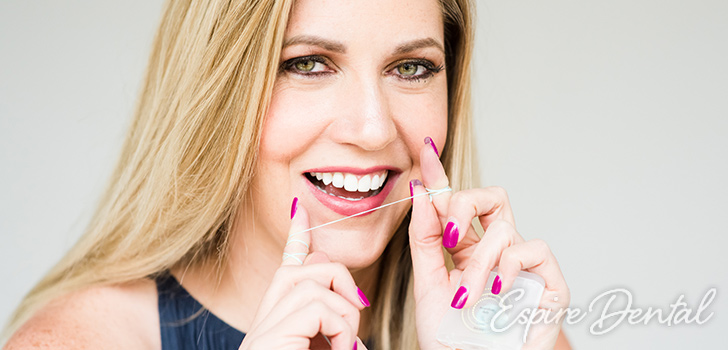
Do you avoid flossing because it’s painful? Here’s why you shouldn’t.
Dental flossing is up there with “eat your vegetables” — something we know we should do but often don’t. Yet flossing is a vital component of maintaining good oral health, and skipping it can lead to serious dental problems, like gum disease.
Perhaps you avoid flossing because it’s painful or has caused bleeding. While unpleasant, these effects are not a good reason to stop! Like daily brushing and regular dental visits, flossing must be part of your everyday oral hygiene routine.
Once you learn the proper techniques, flossing can be a breeze. And any pain you experience will likely go away within a week or two of regular flossing.
Why Does Flossing Hurt?
It’s normal to experience bleeding and pain if you’ve just started flossing. If your teeth are sensitive because the protective outer enamel covering the tooth has worn down, you’re going to feel some pain when you floss, too. But don’t be deterred by some minor bleeding and discomfort. Instead, learn how to floss properly and regularly so you won’t feel any pain.
Flossing removes the bacteria between the teeth that leads to plaque buildup, which causes cavities and gum disease. Although brushing removes most of the plaque from the tooth surface, only flossing can get between the teeth to clear away the plaque that brushing misses.
Some pain during flossing is common, but if flossing causes persistent bleeding, you may have periodontal, or gum, disease. The Centers for Disease Control estimates nearly half of people 30 or older suffer from gum disease. Left untreated, gum disease can lead to bleeding, swollen gums, and bone and tooth loss in more advanced stages. If you notice severe bleeding when you brush and floss, you may be suffering from gum disease that requires treatment from your dentist.
How to Floss Properly
Another reason you may find flossing painful is because you’re doing it wrong. Like learning how to brush your teeth properly, flossing requires a certain technique to produce the best results. Here are three tips to make flossing easier.
- Find the Right Floss. Floss comes in a variety of types, so find the one most comfortable for you. If your teeth are widely spaced, you can use a flat, wide dental tape. On the other hand, a thinner floss works best for teeth that are closer together. Also available are several flossing tools that may make the process easier for you. And if you find flossing too painful, use a water pik to shoot away bacteria and particles between teeth.
- Floss Once a Day. Aim to floss your teeth at least once a day. And floss before you brush, so the brushing dislodges any food bits not removed by the floss.
- Floss Correctly. Unspool between 12 to 18 inches of floss, and grab the floss tightly between your fingers. You need about two inches of clean floss to slide between your teeth. Carefully move the floss in a gentle C motion from one inner tooth surface to the other, making sure not to cut deeply into the gumline. Unwind the floss as you go so you use a clean section of floss for each tooth. This should scrap away any food debris, bacteria, and plaque.
Don’t Neglect Your Oral Health
Regular brushing and flossing are essential for maintaining good oral hygiene, but to prevent serious dental problems, visit your dentist twice a year for a checkup and professional cleaning. The staff at Espire Dental has helped hundreds of patients enjoy a bright and healthy smile. Contact us today for an appointment!
